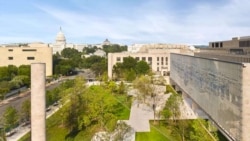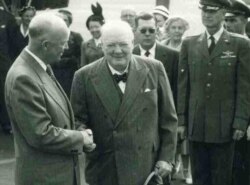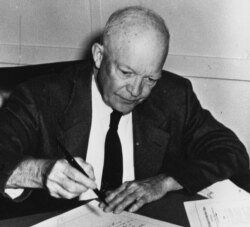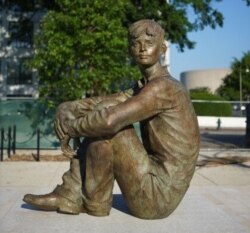Dwight D. Eisenhower was a popular U.S. president known for his integrity, leadership skills, and for balancing the federal budget during his two terms in office from 1953 to 1961.
A lot of people look back favorably at the Eisenhower years “as a time of peace and prosperity,” said Chester Pach, a history professor at Ohio University who has written about the former president.
An innovative new memorial that highlights the accomplishments of the 34th president has opened in Washington, D.C., after a delay of two decades over controversy about the design.
The Eisenhower Memorial is adjacent to the National Mall and near the U.S. Capitol. It features sculptures, a dramatic stainless-steel tapestry and quotes from the president’s speeches etched in stone.
“We paid great attention to historical record so we would be confident in our knowledge about Eisenhower,” explained Carl Reddel, executive director of the Eisenhower Memorial Commission.
The memorial was designed by renowned architect Frank Gehry and tells the story of Eisenhower’s modest beginnings growing up in Abilene, Kansas, his achievements as a military general during World War Two and his accomplishments as president.
“I think what I brought to it was the understanding of how to tell that story,” Gehry told VOA.
Eisenhower had a long and successful military career before he was elected president. As supreme commander of the Allied forces in Europe, he led the D-Day victory in 1944 against Germany’s Nazis on the coast of Normandy, France, which became an important turning point in the war.
Bronze sculptures at the memorial show General Eisenhower rallying paratroopers before entering battle on D-Day.
Later in the 1950s when he ran for president, he was elected to both terms by a landslide.
“He was a likeable war hero who inspired confidence, and people thought they could trust him,” Pach said.
The memorial emphasizes Eisenhower’s successes during his eight years as president, which include supporting the Interstate Highway System, orchestrating the Korean Armistice Agreement and establishing the National Aeronautics and Space Administration.
Eisenhower signed the 1957 Civil Rights Act and sent federal troops to a high school in Little Rock, Arkansas, to enforce court-ordered desegregation of public schools.
“But there was also criticism at the time that Eisenhower did not take the lead in championing desegregation,” Pach said.
His legacy, however, was largely forgotten soon after he left office, said Tim Rives, deputy director of the Eisenhower Presidential Library and Museum in Abilene, Kansas.
Although Eisenhower also had a “reputation as a kind of a do-nothing, golf-playing, nice guy,” Rives said, “his long list of accomplishments is really quite striking,” and “his reputation has gone up dramatically” over the decades.
Gehry said he designed the memorial to reflect “such an important person.”
The architect said he focused on integrating the memorial into the one-and-a-half-hectare area that is now a public park. It is located by federal government buildings related to Eisenhower’s legacy, including the Voice of America.
Disagreements arose over elements of Gehry’s original design, which included a tapestry with a landscape of Abilene, Kansas, that was changed to commemorate D-Day in Normandy.
Despite such changes, Gehry said he is happy with the memorial, which also includes sculptures of Eisenhower as president working with his advisers.
The memorial is framed by the eye-catching stainless-steel tapestry depicting the cliffs of Normandy. At 138 meters long and 19 meters tall, it shimmers during the day and glows at night.
Artist Tomas Osinski, who created the tapestry, said the process began with a drone taking images of the coastline that Gehry used to make a line drawing. Then, a special computer-generated machine that Osinski developed used stainless-steel thread to weave the artistic drawing onto 600 panels that were put together in Washington.
The tapestry is supported by 25-meter columns meant to withstand hurricane-force winds and last for at least a century, Osinski said.
David Eisenhower, the former president’s grandson, recalled the time before his grandfather passed away in 1969 at the age of 78.
He was “a high-energy dynamo, with extraordinary standards, who could master anything he put his mind to,” he said. “My grandfather was thoughtful and considerate and enjoyed being president.”
David Eisenhower said his favorite part of the memorial is the sculpture of the late president as a boy, looking outward with his future ahead of him.
“The memorial shows that someone from rural Kansas could guide the United States in the 1950s and early ‘60s, with wisdom and steadiness,” he said.












